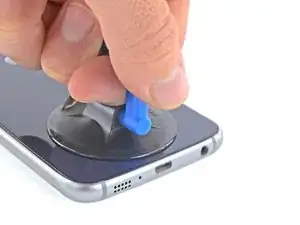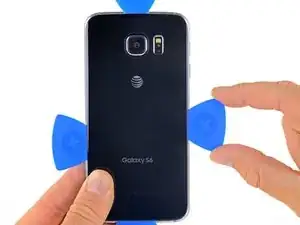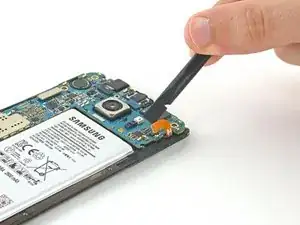Introduction
Use this guide to learn how to replace a broken main camera in your Samsung Galaxy S6 Edge.
This guide involves removing the rear glass. Removing the rear glass destroys the adhesive holding it in place. Follow this guide to reinstall the rear glass.
Tools
Parts
-
-
Insert a paper clip or SIM eject tool into the hole in the SIM card slot on top of the phone.
-
Press to eject the SIM card tray.
-
Remove the SIM card tray from the phone.
-
-
-
Heat the iOpener for thirty seconds.
-
Throughout the repair procedure, as the iOpener cools, reheat it in the microwave for an additional thirty seconds at a time.
-
-
-
Remove the iOpener from the microwave, holding it by one of the two flat ends to avoid the hot center.
-
-
-
Fill a pot or pan with enough water to fully submerge an iOpener.
-
Heat the water to a boil. Turn off the heat.
-
Place an iOpener into the hot water for 2-3 minutes. Make sure the iOpener is fully submerged in the water.
-
Use tongs to extract the heated iOpener from the hot water.
-
Thoroughly dry the iOpener with a towel.
-
Your iOpener is ready for use! If you need to reheat the iOpener, heat the water to a boil, turn off the heat, and place the iOpener in the water for 2-3 minutes.
-
-
-
Lay the heated iOpener over the rear panel for about two minutes to loosen the adhesive around the edge of the glass.
-
Shift the iOpener to heat the remaining section of the panel for another two minutes.
-
-
-
Once the rear glass is hot to the touch, apply a suction cup near the bottom edge of the glass.
-
Lift on the suction cup to create a small gap underneath the rear glass, and insert an opening pick into the gap.
-
-
-
Slide the pick along the bottom edge of the phone to slice through the adhesive securing the rear glass.
-
-
-
Repeat the heating and cutting procedure for the remaining three sides of the phone.
-
Leave an opening pick under each edge to prevent the adhesive from resealing.
-
-
-
Use tweezers to peel away any remaining adhesive from the phone's chassis.
-
Clean the adhesion areas with high concentration isopropyl alcohol (at least 90%) and a lint-free cloth. Swipe in one direction only, not back and forth. This will help prep the surface for the new adhesive.
-
Peel the adhesive backing off of the new rear glass, carefully line up one edge of the glass against the phone chassis, and firmly press the glass onto the phone.
-
-
-
Press down on the back of the battery and lift up on the edges of the midframe to separate it from the rest of the phone.
-
-
-
Using the flat end of the spudger, disconnect the battery ribbon cable from the motherboard.
-
-
-
Use the pointed end of a spudger to disconnect the two antenna interconnect cables from the motherboard.
-
-
-
Grip the motherboard on both edges toward the top of the device.
-
Lift the motherboard up and away from the display, taking care not to put too much stress on the daughterboard ribbon cable.
-
-
-
Use the flat end of a spudger to disconnect the rear-facing camera from the motherboard.
-
Remove the rear-facing camera.
-
To reassemble your device, follow these instructions in reverse order. Follow this guide to reinstall the rear glass.















































First thankful sir that you have a good idea for people to creat like this.. I am very happy from your website its too good. All things i learn from your website thank you..
Lovely Khan -